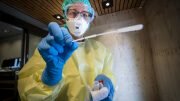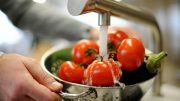Crown Princess Mette-Marit had a video conference with teachers who talked about the new school life with digital teaching.
The Crown Prince couple, like other parents, have recently been trying themselves as teachers at home.
– “There are probably many parents at home who are very grateful for their efforts during these weeks of homeschooling. Many have probably received even more respect for your profession, and how important you are to the children, parents and the whole community,” said the Crown Princess during the video conference with teachers Siri Skjæveland Lode in Jæren, Monica Andreassen in Tromsø and Simen Spurkland in Bærum on Monday.
Crown Princess Mette-Marit praised the efforts of the country’s teachers.
“We are so impressed with how teachers around the country have handled a demanding and urgent change,” she said.
While many students thrive on the new, digital learning style, more are missing out on school and social contact, teachers said during the meeting.
Siri Skjæveland Lode is a member of the central board of the Education Association and says that they have received messages from teachers who are concerned about not having daily contact in the classroom.
They are now happy that schools are gradually re-opening.
On Monday, students in grades 1st – 4th, begin again at school.
© NTB Scanpix / #Norway Today





I understand how much the royal family wants to do anything they can to help in the coronavirus crisis, but putting a happy face on what appears will be a catastrophically bad political decision to re-open schools and workplaces from the lockdown may not be doing that and in fact may have an exactly opposite effect.
Unlike Sweden, Norway does appear to have control over the epidemic here – by resorting to extreme lockdown. (“Social distancing” helps but the most dangerous droplets have a farther range and there is still the virus’s aerosol/vapor threat in closed “viral load” atmospheres like buses and train cars … and school rooms.)
However, there is still no vaccine and the virus is just as sneaky and deadly dangerous as ever … and now here and just waiting.
Schools have always been disease incubators, but kids bringing home this virus can kill their grandparents – many of whom live with immigrant families – and even parents, resulting in horrible, lifelong guilt and anger.
If Norway’s government finally instead fully supported everyone masking – which has made coming out of lockdown possible for China and our Center for Disease Control now supports – there might be some chance of coming out without a catastrophe like Sweden’s, but if the government finally did reverse its anti-mask policy, it will take another week for people to make masks for themselves.
If this madness goes ahead, moving classes outside and/or opening all school windows and even doors to thin the “viral load” in the air as much as possible can help a little.
“Viral load” – the amount of infection a person gets – is important, because if you get hit by – inhale/ingest – a droplet, that is A LOT of infection which can reproduce greatly and rapidly, whereas a tiny vapor/aerosol dose can give the body more, crucial time to detect it and build immunity.
On the other hand, if the aerosol builds in a closed atmosphere – bus, train car, school room with unopened windows (and doors) – it becomes more deadly too … which again is why facemasks are so important … to reduce the viral load.
Independent, 6Apr20: “Coronavirus: How ‘viral load’ and genetics could explain why young people have died from Covid-19,” by Harry Cockburn.
“Some scientists have suggested the greater the amount of virus that infects an individual — known as the “viral load” — could make a large difference to how the body is able to respond to infection.
Put simply, the larger the dose of the virus a person gets, the worse the infection is, and the least promising the outcome.”